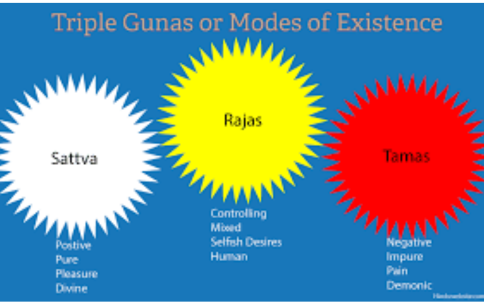Krishna mentioned Gunas (qualities) when he spoke about Varnas. There are three types of gunas viz, Satva, Raja and Tamasa. Satva is gentleness. Raja is egoism. Tamas is ignorance. Brahmans have Satva, Kshatriyas have a mixture of Satva and Raja, Vaisyas have a combination of Raja and Tamasa and Sudras have Tamasa. Though this was generally true there were many exceptions to this principle among both men and women in Hindu spiritual texts. In fact many of the sages who wrote Hindu religious books were not Brahmans by birth. That is proof to say that one is a Brahman by knowledge and wisdom and not by birth. The word Brahman means follower of Brhma who is symbol of wisdom.
Also read: Hinduism – 1
Hindu society is often considered caste ridden. Caste is not connected to Hindu religion. Hindu religious texts mentioned varna but not caste. (You find recorded reference to the word ‘caste’ only when British tried to enlist people of different groups in India in the last years of 19th century). Children born in Hindu families learnt the skills of the profession their parents practised. Society needed every kind of professional service and none was considered superior or inferior. So the society moved on happily. But marriages took place between people belonging to the same profession. The reason is economic. A potter’s daughter acquires some professional skill in pottery as she grows up. If she is married to a potter’s son she becomes an asset to the family. But if the potter’s daughter is married to a weaver or a goldsmith she becomes a liability to that family as she cannot share the work of the family and contribute to its income. So people practising a particular profession became a group and preferred marriages within the professional group. But trouble started much later when a few ill educated egoistic people considered themselves superior and labeled some as inferior. Today when all people are getting educated and almost nobody follows family profession, caste is a meaningless relic of the past. But politicians are keeping it alive for vote banks. Recent declaration of RSS Chief that Hindu society should discard varna and caste is sound advice suited to our times as varna and caste have no meaning in the present society.
Also read: Hinduism – 2
After considering ritual and Code of Conduct parts let us think of the philosophy part of Hinduism. Hinduism is said to be ‘a way of life.’ So let us see the Hindu way of life. Life of a Hindu is divided into four asrams (stages). They are Bahmacharya, Gruhastha, Vanaprastha and Sanyasa. In the first stage one has to acquire knowledge leading a celibate life. In the second stage he marries, follows his profession and fulfils his responsibility towards his family and the society. In the third stage he moves away from home with his wife, leaving his people and his worldly possessions to lead a peaceful retired life. This is a period of serious preparation for spiritual advancement. In the fourth stage he renounces everything including his wife and lives the life of a mendicant.
Also read: Hinduism – 3




